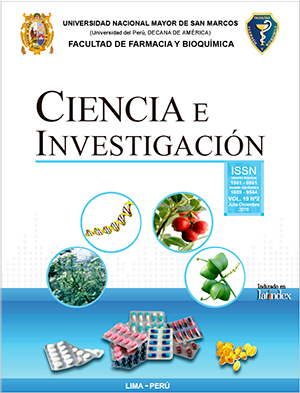Subchronic toxicity and possible teratogenic effect in rats of ethanol extract of Chuquiraga spinosa (huamanpinta)
DOI:
https://doi.org/10.15381/ci.v19i2.13632Keywords:
Chronic toxicity, teratogenic, Chuquiraga spinosaAbstract
Objective of this experimental study was to determine the subchronic toxicity and possible teratogenic effect of ethanol extract from Chuquiraga spinosa (huamanpinta) in Holtzman rats. Was used for the determination of subchronic toxicity 60 rats (30 males and 30 females); the first, control, group received saline solution 4 mL/kg and the second group extract at 200 mg/kg during four consecutive months, making evaluation hematological and biochemical the second, third and fourth month. At the end of the trial (fourth month) was made pathological examination. The determination of possible teratogenic effect was performed using 40 female rats and ten male rats. Female rats recived 200 mg/kg daily by a month before mating and until the birth of brood, was evaluated the number implementations to uterine horns level, live and dead fetuses, and external morphological abnormalities of the offspring. The phytochemical study found that the ethanolic extract showed tannins, phenolic compounds, alkaloids, flavonoids and saponins. In the chronic toxicity test was observed that there was significant difference in hematological and biochemical values to second, third and fourth month of treatment and no histopathological changes in liver, kidney and brain. Regarding to possible teratogenic effect was observed no difference in the weight of pregnant rats, number of fetal implantations, number of live fetuses and morphological abnormalities of the offspring at birth even two months follow up. Was concluded that ethanolic sxtract not showed sub-chronic toxicity or teratogenic effect at 200 mg/kg dose.Downloads
Published
2017-08-02
Issue
Section
Artículos Originales
License
Copyright (c) 2017 Martín Condorhuamán, Luis A. Rojas, Amadeo Collado, Eliana G. Contreras, Jose A. Ortiz, Javier S. Córdova, Eliberto Ruiz, Oscar Herrera

This work is licensed under a Creative Commons Attribution-NonCommercial-ShareAlike 4.0 International License.
LOS AUTORES RETIENEN SUS DERECHOS:
- Los autores retienen sus derechos de marca y patente, y tambien sobre cualquier proceso o procedimiento descrito en el artículo.
- Los autores retienen el derecho de compartir, copiar, distribuir, ejecutar y comunicar públicamente el articulo publicado en la Revista Ciencia e Investigación (por ejemplo, colocarlo en un repositorio institucional o publicarlo en un libro), con un reconocimiento de su publicación inicial en la Revista Ciencia e Investigación.
- Los autores retienen el derecho a hacer una posterior publicación de su trabajo, de utilizar el artículo o cualquier parte de aquel (por ejemplo: una compilación de sus trabajos, notas para conferencias, tesis, o para un libro), siempre que indiquen la fuente de publicación (autores del trabajo, revista, volumen, numero y fecha).
How to Cite
1.
Condorhuamán M, Rojas LA, Collado A, Contreras EG, Ortiz JA, Córdova JS, et al. Subchronic toxicity and possible teratogenic effect in rats of ethanol extract of Chuquiraga spinosa (huamanpinta). Ciencia e investigación [Internet]. 2017 Aug. 2 [cited 2025 Jun. 5];19(2):74-8. Available from: https://revistasinvestigacion.unmsm.edu.pe/index.php/farma/article/view/13632






